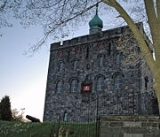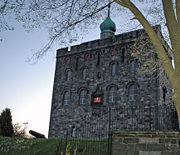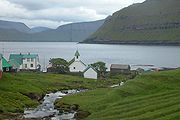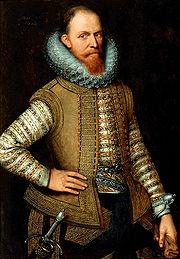
Magnus Heinason
Encyclopedia


Faroe Islands
The Faroe Islands are an island group situated between the Norwegian Sea and the North Atlantic Ocean, approximately halfway between Scotland and Iceland. The Faroe Islands are a self-governing territory within the Kingdom of Denmark, along with Denmark proper and Greenland...
naval hero, trader and privateer
Privateer
A privateer is a private person or ship authorized by a government by letters of marque to attack foreign shipping during wartime. Privateering was a way of mobilizing armed ships and sailors without having to spend public money or commit naval officers...
. He was the son of Heine Havreki
Heine Havreki
Heine Johnsøn Havreki or Heine the shipwrecked was a Norwegian emigrant to the Faroe islands, where he, following the Protestant Reformation, was one of the new followers of the Lutheran church. In 1540 he became the first Lutheran priest on the Faroes.-Early life:Havreki was the son of the...
, a Norwegian priest from Bergen
Bergen
Bergen is the second largest city in Norway with a population of as of , . Bergen is the administrative centre of Hordaland county. Greater Bergen or Bergen Metropolitan Area as defined by Statistics Norway, has a population of as of , ....
who emigrated to the Faroe Islands and who helped introduce the Lutheran Reformation
Protestant Reformation
The Protestant Reformation was a 16th-century split within Western Christianity initiated by Martin Luther, John Calvin and other early Protestants. The efforts of the self-described "reformers", who objected to the doctrines, rituals and ecclesiastical structure of the Roman Catholic Church, led...
to the Faroe Islands, and Gyri Arnbjørnsdatter, Havreki's second wife from a powerful and weathly Norwegian clan.
Magnus Heinason was engaged three times and married twice.
Magnus had a son with a Faroese lady Kollfina in ca. 1560. Rasmus Magnussen (1560–1670) lived to the age of 110 years old, and at the age of 103 was himself father of a son.
In 1580 Magnus met a Norwegian noble lady Margrethe Axeldatter Gyntersberg or von Güntersberg (1565–1589). They had a child Mogensbarn that died as child. They did not marry because she accused him of rape. The noble family then demanded that he marry Margrethe's younger sister, Sophie Axeldatter Gynhterberg (1566–1607). They married in 1582 in Bergenhus
Bergenhus
Bergenhus is a borough of the city of Bergen, Norway.-Location:Named after the historic Bergenhus Fortress, Bergenhus makes up the city centre and the neighborhoods immediately surrounding it, including Sandviken and Kalfaret, as well as the mountains to the north and east of the city centre...
, Bergen and had one daughter, Elsebeth Magnusdatter (1584–1645).
Magnus Heinason served William the Silent
William the Silent
William I, Prince of Orange , also widely known as William the Silent , or simply William of Orange , was the main leader of the Dutch revolt against the Spanish that set off the Eighty Years' War and resulted in the formal independence of the United Provinces in 1648. He was born in the House of...
and his son Maurice of Nassau, Prince of Orange
Maurice of Nassau, Prince of Orange
Maurice of Nassau, Prince of Orange was sovereign Prince of Orange from 1618, on the death of his eldest half brother, Philip William, Prince of Orange,...
for 10 years as a privateer, fighting the Spanish in the Dutch Revolt
Dutch Revolt
The Dutch Revolt or the Revolt of the Netherlands This article adopts 1568 as the starting date of the war, as this was the year of the first battles between armies. However, since there is a long period of Protestant vs...
. Magnus Heinason was given the trading rights to the Faroe Islands by Frederick II of Denmark and Norway from 1559 to 1588. Later he received letters of marque to sink or capture pirate ships and English
England
England is a country that is part of the United Kingdom. It shares land borders with Scotland to the north and Wales to the west; the Irish Sea is to the north west, the Celtic Sea to the south west, with the North Sea to the east and the English Channel to the south separating it from continental...
merchant ships.
Magnus built the first fortifications in Tórshavn
Tórshavn
Tórshavn is the capital and largest town of the Faroe Islands. It is located in the southern part on the east coast of Streymoy. To the north west of the town lies the high mountain Húsareyn, and to the southwest, the high Kirkjubøreyn...
. Only one year later, he was captured and sent to Copenhagen
Copenhagen
Copenhagen is the capital and largest city of Denmark, with an urban population of 1,199,224 and a metropolitan population of 1,930,260 . With the completion of the transnational Øresund Bridge in 2000, Copenhagen has become the centre of the increasingly integrating Øresund Region...
on the orders of the Danish
Denmark
Denmark is a Scandinavian country in Northern Europe. The countries of Denmark and Greenland, as well as the Faroe Islands, constitute the Kingdom of Denmark . It is the southernmost of the Nordic countries, southwest of Sweden and south of Norway, and bordered to the south by Germany. Denmark...
Treasurer and Statholder, Christofer Walkendorf who was ruling Denmark
Denmark
Denmark is a Scandinavian country in Northern Europe. The countries of Denmark and Greenland, as well as the Faroe Islands, constitute the Kingdom of Denmark . It is the southernmost of the Nordic countries, southwest of Sweden and south of Norway, and bordered to the south by Germany. Denmark...
at that time.
Magnus Heinason was tried, and shortly thereafter he was beheaded. His remains were excavated and taken to Ørslev kloster where he lies to this day.
Early life
In his job as a priest in the Faroes, Magnus' father, Heine Havreki travelled much by sea, to and from the islands. Magnus accompanied him on these journeys. Even as a little boy Magnus knew how to sail small boats and gained a lot of experience that would be useful later in life. As a grown man in his career as a seamanSeaman
Seaman is one of the lowest ranks in a Navy. In the Commonwealth it is the lowest rank in the Navy, followed by Able Seaman and Leading Seaman, and followed by the Petty Officer ranks....
and a privateer he would carry out some of his famous and finest acts in these same waters.
Magnus the young man


Norway
Norway , officially the Kingdom of Norway, is a Nordic unitary constitutional monarchy whose territory comprises the western portion of the Scandinavian Peninsula, Jan Mayen, and the Arctic archipelago of Svalbard and Bouvet Island. Norway has a total area of and a population of about 4.9 million...
. The family moved to Bergen, where Magnus lived out his dream of becoming a seaman, through family connections on his father's side. At a young age he was made captain
Captain (nautical)
A sea captain is a licensed mariner in ultimate command of the vessel. The captain is responsible for its safe and efficient operation, including cargo operations, navigation, crew management and ensuring that the vessel complies with local and international laws, as well as company and flag...
of a trade ship on the route that his father had sailed for many years, Bergen to the Faroe Islands. On his third trip he was attacked by pirates. How this happened is not known but when he arrived in Bergen, people made him look an idiot for giving up without a fight. He was deeply hurt by this, and swore that he would take revenge. He left Norway and went to Netherlands
Netherlands
The Netherlands is a constituent country of the Kingdom of the Netherlands, located mainly in North-West Europe and with several islands in the Caribbean. Mainland Netherlands borders the North Sea to the north and west, Belgium to the south, and Germany to the east, and shares maritime borders...
in the Navy. Little is known about this part of Magnus’ life. Returning about 10 years later with commendations from Maurice of Nassau, Prince of Orange
Maurice of Nassau, Prince of Orange
Maurice of Nassau, Prince of Orange was sovereign Prince of Orange from 1618, on the death of his eldest half brother, Philip William, Prince of Orange,...
and his father William the Silent
William the Silent
William I, Prince of Orange , also widely known as William the Silent , or simply William of Orange , was the main leader of the Dutch revolt against the Spanish that set off the Eighty Years' War and resulted in the formal independence of the United Provinces in 1648. He was born in the House of...
for bravery in combat at sea against the Spanish
Spain
Spain , officially the Kingdom of Spain languages]] under the European Charter for Regional or Minority Languages. In each of these, Spain's official name is as follows:;;;;;;), is a country and member state of the European Union located in southwestern Europe on the Iberian Peninsula...
in the Dutch Revolt
Dutch Revolt
The Dutch Revolt or the Revolt of the Netherlands This article adopts 1568 as the starting date of the war, as this was the year of the first battles between armies. However, since there is a long period of Protestant vs...
, that later resulted in the liberty of the Dutch
Netherlands
The Netherlands is a constituent country of the Kingdom of the Netherlands, located mainly in North-West Europe and with several islands in the Caribbean. Mainland Netherlands borders the North Sea to the north and west, Belgium to the south, and Germany to the east, and shares maritime borders...
people from the Spanish crown.
Returning to Denmark
Magnus returned to Denmark with good recommendations from Maurice of Nassau, Prince of OrangeMaurice of Nassau, Prince of Orange
Maurice of Nassau, Prince of Orange was sovereign Prince of Orange from 1618, on the death of his eldest half brother, Philip William, Prince of Orange,...
, that he later in life would use when he met the Danish King, Frederick II of Denmark and Norway. It is likely that Magnus had a dream of moving back to Bergen and taking back his old job as captain on the trade route between Bergen and the Faroe Islands, with the difference that he would own the ship himself. The plan is very clear, while Magnus was in the Netherlands, his half-brother Jón Heinason was made Løgmaður, in 1571. But Magnus's dreams of getting the trade route rights or as said the monopoly
Monopoly
A monopoly exists when a specific person or enterprise is the only supplier of a particular commodity...
rights to the Faroe Islands he must have been disappointed, because the Treasurer and Statholder (or in Danish
Danish language
Danish is a North Germanic language spoken by around six million people, principally in the country of Denmark. It is also spoken by 50,000 Germans of Danish ethnicity in the northern parts of Schleswig-Holstein, Germany, where it holds the status of minority language...
, Rentemester), Christoffer Valkendorff
Christoffer Valkendorff
Christoffer Valkendorff was a Danish statesman and Steward of the Realm.He descended from a German immigrant aristocratic family. During the 1550s he made himself a career in Norway where he successfully opposed the last remains of Hanseatic influence, which earned him the benevolence of King...
had cancelled the old fashion of giving the rights out to private merchants. Now the ships that were trading on the Islands were sent by the royal trade and on their expense, so the monopoly started in 1578, the first year we first hear about Magnus’ returns home, he hears about this horrible way of trading.
The monopoly
Magnus went to the King, to improve his position as a worthy man to take over the trade on the Faroe Islands, but the King was not pleased that he should give the monopoly trade away, now that he had purchased it for himself. But then Magnus used the excuse that someone owed him money on the Faroes, and he had to collect them!, he wanted the King to grant him a special travel pass, to one trip from Bergen to the Faroe Islands, so he could get what was his. The King couldn't see anything wrong in that since it was a man of word and honour that was standing in front of him. But before he gave him the free pass, he ensured that Magnus wouldn't trade goods even though if the people that owed him money, didn't have any and would give goods instead, he would had to bring all the goods with him to the king and hand them over. Magnus agreed, the King granted the trip and Magnus left CopenhagenCopenhagen
Copenhagen is the capital and largest city of Denmark, with an urban population of 1,199,224 and a metropolitan population of 1,930,260 . With the completion of the transnational Øresund Bridge in 2000, Copenhagen has become the centre of the increasingly integrating Øresund Region...
, in the beginning of his return to his old home country, he tries to bend the rules of his journey, but he had other plans in mind. He had talk with several of the farmers and high standing people on the Faroes including his half brother Løgmaður Jógvan Heinason the high Judge of the Faroes, and talked them into a kind of a small rebellion against the newly started monopoly trade! And Magnus had success. The claims of the people on the Islands to the king were, that instead of the king leading the trade, a supervisor should take care of the books and make sure everything was legal. If the King wouldn’t agree to this claim, the Faroese people, asked for that there should be a man on the Islands holding a ship in command of his own, so he could travel between the Faroe Islands and Bergen to trade timber and weeds, since there were a constant lack of this on the Islands since the new trade ways were started.
On the ting
Thing (assembly)
A thing was the governing assembly in Germanic and introduced into some Celtic societies, made up of the free people of the community and presided by lawspeakers, meeting in a place called a thingstead...
no names where said, but it was clear what they had in mind. the Faroese claims were presented to the King, in December 1578 in Koldinghus
Koldinghus
Koldinghus is a Danish royal castle on the south central part of the Jutland peninsula in the town of Kolding. The castle was founded in the 11th century and was expanded since with many functions ranging from fortress, royal residency, ruin, museum, and the location of numerous wartime...
, the Faroese men that had travelled all the way to Kolding
Kolding
Kolding is a Danish seaport located at the head of Kolding Fjord in Region of Southern Denmark . It is the site of the council Kolding Municipality. It is a transportation, commercial, and manufacturing centre, and has numerous industrial companies, principally geared towards shipbuilding...
, said that they would like a man named Magnus Heinason as the commander of these ships. The King wouldn’t take this decision himself instead he handed it over to his Treasurer and Statholder Christoffer Valkendorff to make a count of what would be best for the King since it was Christoffer Valkendorff that had proposed the King to start the Royal Monopoly trade. Meanwhile Christoffer and the clerks were counting and checking books for some days Magnus made good friends with king Frederick II of Denmark and Norway. And any way what number Christoffer ended on, or how the loss where, course Magnus had talk Frederik the II, into grant him the command of the ships and give him the trade rights. And then Christoffer Valkendorff's plan of making monopoly trade on the Faroes were gone. The Faroese now would send all goods that were produced in the Faroe Islands, with ships owned by Magnus Heinason and in return all goods needed on the Islands, timber, beer, weeds, would be provided by Magnus’ fleet!
Pirates raiding Tórshavn
In the summer of 1579 Tórshavn was raided by a ScottishScotland
Scotland is a country that is part of the United Kingdom. Occupying the northern third of the island of Great Britain, it shares a border with England to the south and is bounded by the North Sea to the east, the Atlantic Ocean to the north and west, and the North Channel and Irish Sea to the...
pirate named Klerck. Magnus first heard of this when he landed in Tórshavn. The Scots had taken most of the King's taxes, and also a lot of private goods that were stored in Tórshavn. Magnus had lost goods that were meant to be sold and then taxed by the King. Magnus left the Faroe Islands and went to Denmark to make his case in front of the King. He wanted the King to cover the loss of the goods since Magnus had paid for them and the King would receive taxes of them. The King agreed to cover half the loss and Magnus the other part. Magnus was not pleased by this, so he made a proposal to the King, that he could arm his merchant ships with cannons, so that he could fight the pirates or at least take them prisoner and take them to shore for trial. Since he had served in war in the Dutch
Netherlands
The Netherlands is a constituent country of the Kingdom of the Netherlands, located mainly in North-West Europe and with several islands in the Caribbean. Mainland Netherlands borders the North Sea to the north and west, Belgium to the south, and Germany to the east, and shares maritime borders...
navy, and had fine recommendations from Maurice of Nassau, Prince of Orange
Maurice of Nassau, Prince of Orange
Maurice of Nassau, Prince of Orange was sovereign Prince of Orange from 1618, on the death of his eldest half brother, Philip William, Prince of Orange,...
, King Frederick II of Denmark and Norway agreed. Furthermore King Frederick mentioned the Oresund
Oresund
The Sound , is the strait that separates the Danish island Zealand from the southern Swedish province of Scania. Its width is just at the narrowest point between Helsingør, Denmark, and Helsingborg, Sweden...
taxes, that he said were losing money on, especially because Dutch merchants were sailing the northern way around Norway into the White Sea
White Sea
The White Sea is a southern inlet of the Barents Sea located on the northwest coast of Russia. It is surrounded by Karelia to the west, the Kola Peninsula to the north, and the Kanin Peninsula to the northeast. The whole of the White Sea is under Russian sovereignty and considered to be part of...
to trade with Russia, instead of going the short way between Denmark and Sweden
Sweden
Sweden , officially the Kingdom of Sweden , is a Nordic country on the Scandinavian Peninsula in Northern Europe. Sweden borders with Norway and Finland and is connected to Denmark by a bridge-tunnel across the Öresund....
through Oresund. So Magnus got letters of marque to stop and take prize any ship that indented to travel north around Norway. But with the rule that Magnus did not attack any merchant or navy vessels of any nation if they were travelling the "right way".
Literature
The Faroese priest Lucas DebesLucas Debes
Lucas Jacobsøn Debes was a Danish priest, topographer and celebrated writer about the Faroe Islands. He wrote the first book about the Faroes, which was printed and draw the first detailed map of the islands.-His Arrival to Tórshavn:Debes came to the Faroe Islands in 1652 as a curate...
commented in his lifework Færoæ & Færoa Reserata:

